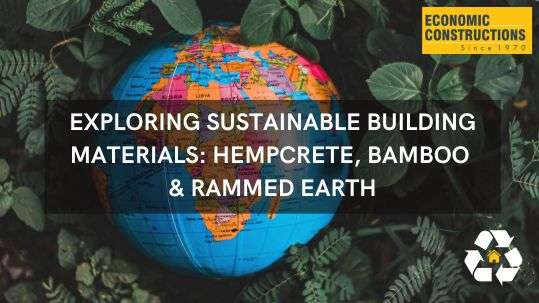
23 May Exploring Sustainable Building Materials: Hempcrete, Bamboo and Rammed Earth
The construction industry has been focusing on using eco-friendly building materials in its goal for a more sustainable and greener future. The use of these materials in building can be crucial in lowering our carbon footprint and protecting the environment for future generations as we work towards a more sustainable world. This blog will discuss three remarkable sustainable building materials like bamboo, rammed earth and hempcrete that are adopted for use in construction.
1. Bamboo: Nature’s Gift for Construction
Due to its extraordinary strength and adaptability, bamboo is frequently referred to as “the steel of the 21st century”. It is not just used for its strength but also for its aesthetic appeal, resulting in buildings that beautifully blend with their surroundings.
Advantages of bamboo
• Rapid Growth: Bamboo grows very quickly with some species reaching maturity in a few years. As a result, it is a renewable resource, which decreases the burden on forests.
• Strength and Durability: Bamboo is strong and durable, making it a great choice for beams, columns, and other structural components.
• Low Environmental Impact: Growing bamboo uses less water and pesticides, which lowers the carbon impact of buildings.
2. Rammed Earth: Traditional Knowledge and Contemporary Sustainability
The construction industry has restored the ancient practice of rammed-earth construction into contemporary building techniques. With this technique, solid, load-bearing walls are created by compressing a mixture of earth, chalk, lime, or gravel.
Advantages of rammed earth
• Sustainability: The manufacture of rammed earth uses less energy and mostly uses natural resources and nearby materials, which lowers transportation expenses.
• Thermal Mass: These walls offer great thermal insulation, assisting in the naturally occurring maintenance of cosy indoor temperatures.
• Aesthetic Appeal: Rammed earth constructions have an organic texture and colour that give buildings a unique style.
3. Hempcrete: Utilising Hemp to Build
Although hempcrete is a relatively new entrant in the market for sustainable building materials, it has enormous potential. To form a thin, insulating substance, the inner fibres of the hemp plant are combined with lime and water.
Advantages of Hempcrete:
• Carbon Capture: Hempcrete is a carbon-negative building material because it absorbs carbon dioxide during manufacture and growth.
• Insulation: It provides great thermal and sound insulation, which lowers energy use and improves indoor comfort.
• Non-Toxic: Hempcrete is non-toxic, which promotes better indoor air quality.
Building companies’ efforts to use bamboo, rammed earth, and hempcrete in buildings not only reduce the environmental impact of their projects but also provide their clients with stunning, useful, and eco-friendly spaces. It sets an example for the construction industry by exploring these cutting-edge materials, proving that eco-friendly building methods are not simply a trend but an ethical and sensible option for the future.

No Comments